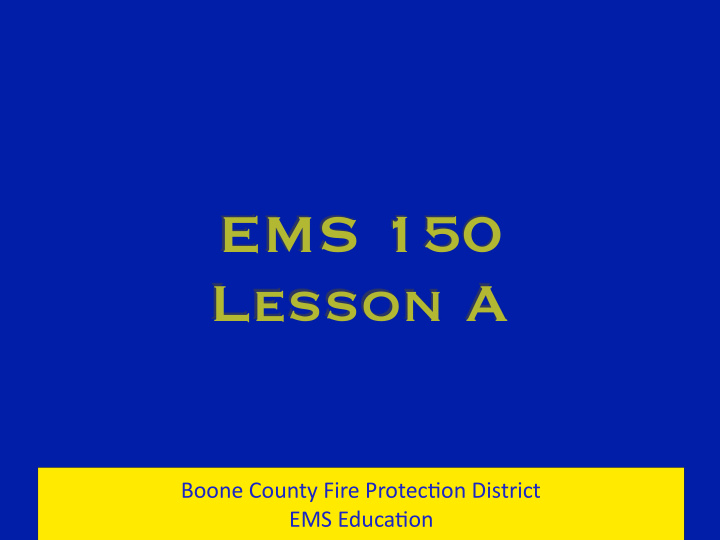



EMS 150 Lesson A Boone County Fire Protec/on District EMS Educa/on
Course Overview • Assessment Flowchart • Assessment Inventory • Underlying Theme Circulation (Shock / Types of Shock) • Ventilation • Oxygenation • Boone County Fire Protec/on District EMS Educa/on
Lesson A Overview • Assessment Skills • Emergent / Immediate Interventions • Circulation-Ventilation-Oxygenation Boone County Fire Protec/on District EMS Educa/on
Flowchart • Is this a “code” (cardiac arrest)? • CVO assessment • Immediate interventions? • Focused H&P to drive a differential Dx list • Ddx drives specific interventions / plan of care Boone County Fire Protec/on District EMS Educa/on
Inventory • All of the things you MUST consider • Determine WHICH you will do / utilize • Few patients need ALL of these things • Prioritize / delegate • Gather data / toss out noise / get information Boone County Fire Protec/on District EMS Educa/on
CVO • Major Body Processes • Must Circulate blood • Must Ventilate air for gas exchange • Must Oxygenate the blood to be circulated Boone County Fire Protec/on District EMS Educa/on
Circulation • Shock defined • Obstructive Shock defined • Hypovolemic Shock defined • Cardiogenic Shock defined • Distributive Shock defined • Assessment options (pulses, skin, HR, BP) Boone County Fire Protec/on District EMS Educa/on
Ventilation • Rate of breathing • Effort / work of breathing • Depth of breathing (“dead spacing”) • EtCO2 as a tool Boone County Fire Protec/on District EMS Educa/on
Oxygenation • Adequate O2 content inspired • Intact process in alveoli for gas exchange • Assessment challenges (SpO2 limitations) • Lung Sounds assessment Boone County Fire Protec/on District EMS Educa/on
Lab A • Pulse oximetry • Capnography • ECG limb leads • BP via auscultation, palpation, doppler, use of machine pressures • Lung Sounds auscultation Boone County Fire Protec/on District EMS Educa/on
More for Lab A • Two-thumbs down / BVM ventilation • Oxygen Therapy • PEEP via BVM, CPAP, BiPap • Nebulizer treatments Boone County Fire Protec/on District EMS Educa/on
Pulse Oximetry • Not real time—may be 1-2 minutes old • Signal strength is key to check before you start believing the number (match to pulse) • Requires adequate perfusion—patient with SpO2 of 60 and BP of 60 example • Can be fooled by Carbon Monoxide (CO) Boone County Fire Protec/on District EMS Educa/on
Capnography • Real time—no delay • Requires adequate metabolism to make CO2 at the cells • Requires adequate circulation to bring back CO2 to the lungs • If those two are intact, shows you ventilation data—number and waveform shape matters Boone County Fire Protec/on District EMS Educa/on
HR and Breathing • Radial pulse palpation is a great 1st step • Touch is good (let’s you feel skin) • Look at the patient’s breathing rate, effort and depth while holding their pulse • Presence lets you estimate BP • Rate and Regularity gives you data on Heart Boone County Fire Protec/on District EMS Educa/on
Blood Pressure • Size and place the cuff • Auscultate when you can hear • Palpate when you cannot hear but can feel a pulse • Doppler when you cannot hear or feel a pulse • Machines don’t forget to take it or what it was Boone County Fire Protec/on District EMS Educa/on
Two-Thumbs Down • Big muscles of your hands make the seal • Jaw thrust at the same time • Very important • Takes skill—more than squeezing a bag! Boone County Fire Protec/on District EMS Educa/on
BVM Ventilation • Do NOT use too much volume—hurts BP • DO get normal chest rise • Adult BVM holds 1500 cc!!!!! • Looking for tidal volume of 300-500 for most adults—taller needs more • ONLY use two hands when you need more pressure (think about why)—not volume Boone County Fire Protec/on District EMS Educa/on
Oxygen Therapy • “Normal” varies if patient has lung disease • Target is 94-99% for those without lung disease • Adjust your target downward for lung disease • 90-95% may be their norm • 5% below “normal” Boone County Fire Protec/on District EMS Educa/on
O2 Tools • Nasal cannula at 2-3 liters per minute for 2-3 minutes should raise the SpO2 by 2-3 points. • If you need more than 2-3 points, use the NRBM. • If the SpO2 is not rising toward “normal” with cannula as above, consider why…may be a ventilation problem?? Boone County Fire Protec/on District EMS Educa/on
PEEP • Recruits all available alveoli into the game • Reduces work of breathing—prevents atelectasis • Conscious patients may not like the tight- fitting mask at first • Raises intra-thoracic pressure which may reduce preload (reduce BP) Boone County Fire Protec/on District EMS Educa/on
CPAP or BiPAP • Continuous Positive Airway Pressure • Bi-level Positive Airway Pressure Boone County Fire Protec/on District EMS Educa/on
Nebulizer Tx • Makes tiny droplets out of the medication • Patient can hold or can be attached to a mask • Can use with CPAP / BiPAP mask usually • Beware of dead-spacing Boone County Fire Protec/on District EMS Educa/on
Recommend
More recommend